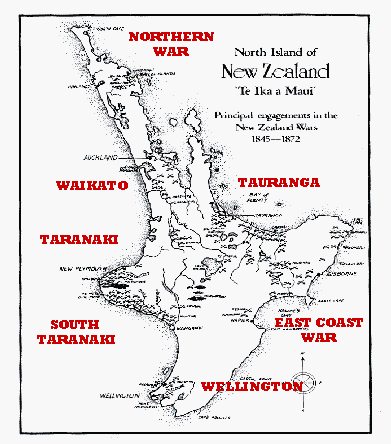Campaigns of the New Zealand Wars

Historical map showing approximate locations of major campaigns (low resolution)
The Northern War, 1845 - 1846
Started with Hone Heke repeatedly removing the flagpole at Maiki Hill (Flagstaff hill), and attacking the settlement of Kororareka, it ended with the battle of Ruapekapeka, this first war marked a dramatic change in how the Maori faught using an invention of the Chief Te Ruki Kawiti, that would less than a hundreds years later change the face of modern warfare, trench-warfare.
Northern/Flagstaff war further readingWellington and Whanganui, 1846-1847
Began after land disputes, a recurring theme across the whole conflict, with the local Iwi around Wellington and separately around Whanganui.
Wellington/Hutt Valley campaign further readingWhanganui war further reading
(North) Taranaki, 1860-1861
Land disputes again caused this, with the battle of Te Kohia beginning the so-called 'great civil wars of the 1860s (James Belich, The New Zealand Wars DVD)'.
First Taranaki war further readingWaikato, 1863-1864
Began with the British invading the Maori King's home area of The Waikato, after a major engagement at Rangiriri the British pushed south and eventually defeated the Maori at Orakau, at which point the Maori King Tawhiao fled and took refuge with Ngāti Maniapoto in the area later known as the 'King Country'
Invasion of the Waikato further readingTauranga, 1864
The Battle of Gate Pā quickly followed the fall of The Waikato, it occurred as Bay of Plenty warriors returned from supporting the Maori King.
Tauranga campaign further reading(Central-South) Taranaki, 1865-1869
After the war in North Taranaki (1860/61) land owned by Maori 'deemed to have been in armed rebellion against the Crown' were confiscated. And so we have land disputes as the cause again.
Second Taranaki campaign further readingEast Coast: 1864-1872
Marked the end of the Maori civil war, and the capture, and later escape, of Te Kooti, a larger-than-life figure that went on to lead the British Army and their allies on a merry dance across The Ureweras constantly escaping re-capture, until he settled peacefully in Te Kūiti.
The East Coast war further reading